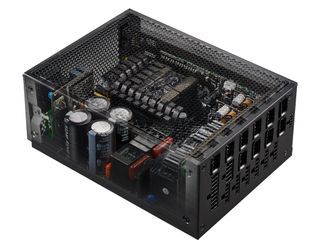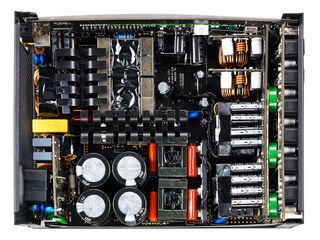Cooler Master Reveals The Long-Awaited MasterWatt Maker 1200 PSU

After a long wait, Cooler Master finally revealed its top-of-the-line PSU offering, the Titanium efficiency MasterWatt Maker 1200. This unit is based on a digital platform made by Enhance Electronics, and in addition to a Windows application called Cooler Master Connect, CM also developed apps for iOS and Android devices, which means that you will be able to monitor/control the PSU through your smartphone or tablet via the Bluetooth V4.0 protocol.
At CES 2016, we were informed about two MasterWatt models with 1.2 kW and 1.5 kW capacities, respectively, but it seems only the smaller unit will hit the production line, at least for now. Hopefully, we will also see the larger version released in the near future.
The MasterWatt Maker 1200 addresses enthusiast users who aren't intimidated by the high price tag, which, according to our sources will be close to 400 bucks. Such a high price puts it on par with the top-notch, and even stronger, Corsair AX1500i, which currently holds the top place in our relative performance chart. Consequently, the MasterWatt has to offer ultra-high performance levels in order to be a more appealing choice.

According to CM, the unit uses a 3D circuit design that drastically reduces energy loss and saves some internal space. Restricting energy losses is of immense importance when you're after Titanium efficiency. A shot at the internals shows a pretty cramped PCB. There are four bulk caps, and we also noticed a full-bridge design, with the primary switching FETs installed onto a relatively small heatsink. The other two heatsinks retain Enhance's characteristic design, although their fins aren't so long. The electrolytic caps are provided by Rubycon, so it is safe to assume that they are of high quality. Polymer caps filter the minor rails.
The couple of PFC chokes is an indication for an interleaved PFC, where two APFC converters operate in parallel, with a phase difference among them--something that leads to reduced input/output current ripple and also lowers conduction losses. This translates to higher efficiency, and on top of that, it doubles the effective switching frequency.
On the modular board, Enhance uses a number of polymer caps in order to further suppress ripple. Given that so far Enhance hasn't released a platform able to meet Super Flower's ripple performance, we're curious to see how the MasterWatt will fare in this area. Reducing ripple demands the usage of an extra number of components (i.e., capacitors and chokes) and naturally a percentage of energy is lost on these parts, especially at higher loads. This is why most manufacturers choose to sacrifice a part of ripple performance in order to achieve high efficiency levels.
However, this is a digital platform, so it doesn't have the limitations of analog designs. Therefore, it should be able to score high efficiency and low ripple at the same time, and taking into account the fast response time of digital controllers, we also expect strong performance in transient tests. Nonetheless, we will have more solid data on this PSU's performance once we have the MasterWatt on our test bench.
Stay on the Cutting Edge
Join the experts who read Tom's Hardware for the inside track on enthusiast PC tech news — and have for over 25 years. We'll send breaking news and in-depth reviews of CPUs, GPUs, AI, maker hardware and more straight to your inbox.


The cooling fan (Silencio FP) has a 135 mm diameter and promises especially silent operation. The fan's job becomes easier when the thermal loads are low, something should be possible in such a high-efficiency PSU.
The PSU utilizes a fully modular cabling design featuring specially-designed cables, with heavy duty connectors on the PSU side that, according to CM, are able to handle increased amperage (up to 1.5x more) compared to normal connectors.
The MasterWatt Maker 1200 will hit the market sometime in June, and as we already stated, its price will be around $400, so if you're planning to purchase one, you better start saving money.
| Model | MPZ-C001-AFBAT |
|---|---|
| Type | ATX 12V, Fully Modular |
| PFC | Active PFC (over 0.95 typical) |
| Input Voltage | 100-240VAC |
| Input Current | 12-6A |
| Input Frequency | 47-63 Hz |
| Dimensions | 200 x 150 x 86 mm (LxWxH) |
| Fan type | 135 mm Silencio FP fan |
| PowerGood Signal | 100-500ms |
| Hold Up Time | 16ms |
| Average Efficiency | 90-94% |
| MTBF | 100,000 hours |
| Protections | OPP, OVP, OCP, SCP, OTP |
| Safety Standards | TUV, CE, FCC, BSMI, EAC, RCM, CCC, KC |
| Connectors | MB 20+4 Pin x 1CPU 12V 4+4Pin x 2PCI-e 6+2 Pin x 10SATA x 164Pin Peripheral x 124Pin Floppy x 1 |
Aris Mpitziopoulos is a Contributing Editor at Tom's Hardware US, covering PSUs.
-
Nuckles_56 Thanks the the bluetooth link this unit is massively over priced now, I hope for CM's sake, it performs perfectly or they will have to cut the price a lot to competeReply -
Nintendork The day when the 1st smart maker will focuses on 300-500w 80+ Titanium PSU and the market by storm.Reply
10-20% efficiency (30-50 / 60-100w) is what people load on their PC's 95% of the time. -
NeatOman Now that GPU's like the GTX 1080 with a TDP of 180 watts will only be designed for two way SLI and CPU's like the i7-6700k overclocked only use about 130+ watts its hard to see why you would ever need a PSU that has more than 800 watts of clean output :/ Which would still give you a 200 watt buffer with everything overclocked and running fans, drives, pump etc.Reply
I ran a Corsair CX430 with a FX-8320 @4.5GHz with a HD 7950 @1250MHz GPU/1650MHz VRAM and two HDD's, 3x120mm fans. Its not the same CX430 you can buy now, it was a B grade high quality PSU rebadged for Corsair and used Jap capacitors. Had clean 25mw ripple at 430 watts output and could put out 460 watts within specs. I did that just to see what i could get away with lol, but it ran cool at full load and ran 24/7/365 as a gaming machine, work station, and a media/file server. But now i run a PC Power & Cooling Silencer MK III 850 that i picked up for $80 because OCZ bought them out and they dropped the price on the "PC Power & Cooling" brand. It was also open box, but a 7 year warranty covered by OCZ is fine with me. -
Xyne 1% to 5% efficiency would interest me, I need about 700-800 Watts for SLI but at idle the computer draws less than 30W on the Wall...Reply -
Rogue Leader ReplyThe day when the 1st smart maker will focuses on 300-500w 80+ Titanium PSU and the market by storm.
10-20% efficiency (30-50 / 60-100w) is what people load on their PC's 95% of the time.
I don't agree, Seasonic already makes gold efficiency low wattage PSU's, no they aren't titanium, but they also don't sell very well either. Even the reviews say "this PSU is great but why would i buy a 450w psu when I can get a 600w for the same price", there comes a point of diminishing returns and wattage that low isn't worth building in that high quality. The less informed enthusiasts out there make up the bulk of the market and they aren't buying it. -
hellwig I'm trying to wrap my head around the connections.Reply
Assuming those 6 connectors with a single row of five pins each are for the SATA/Molex connectors, I'm guessing you can't plug in all 16 SATA and 12 Molex at the same time?
10 PCIe connectors is a configuration I am unfamiliar with. Is this for bitcoin mining? Is that still profitable with GPUs? Maybe it's for a massive Tesla rig.
Most Popular


